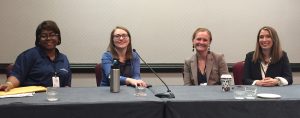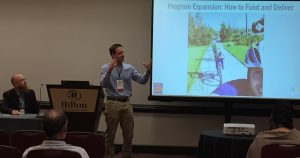Last month, our staff and a handful of coordinators from across the state headed to Tampa for the 2019 National Safe Routes to School Conference.

We shared the significant improvements happening in Detroit and Traverse City and were surrounded by colleagues that shared their progress across the country. Hearing how we collectively make it safe, convenient and fun for children to bicycle and walk to school reminded us of the significance of our work.
Beyond sharing some of the great work happening in Detroit and Traverse City, we were surrounded by people across the country with their minds set on how to make walking and biking to school safer for students, more fun for everyone involved, and the easy option for families to choose.

Here are a few take-a-ways from the conference:
- Not for youth, but with youth– Incorporating youth insights, voices, and decisions during program development and implementation can be challenging, but are worth the effort to foster youth. They can take ownership of the program in was that can lead to innovative and creative designs, and programs that work for students.
- Partners in health– Health departments can be a strong partner to our work by highlighting the compounding effects of health disparities that interact with transportation needs. They can add capacity to your planning and implementation processes, share data insights, and identify funds to maximize program investment efficiency.
- Public engagement over outreach– There’s a vast difference between public outreach and quality engagement. Outreach shares project details while engagement is a transparent process to map community priorities. Public engagement identifies and invests in community leaders to mobilize local community participation.
- Safe routes to everywhere– The conference host, Safe Routes Partnership, is an advocacy organization which recently expanded their focus beyond Safe Routes to School. In support of this shift, they provided content about the importance of connectivity beyond getting to school. While our focus and funding are aligned with school routes, we know other benefits that occur when communities keep their parks, health care services, and other features in mind. This expanded vision fosters the creation of healthy communities for everyone.
- Strategic storytelling– There will be times when sharing experiences and perceptions about how transportation systems impact our daily lives moves beyond principles, bullet points, and data. Knowing how to tell a story can directly and indirectly influence community policies, regulations and projects. Strategic storytelling can be an effective tool to communicate something is at stake. By telling the stories of people in the communities we serve, especially those often left out of public discourse- children, elderly, persons with disabilities, non-English speakers and others, can raise awareness and connect the community to our work.
Check out the conference session slides. They offer best practices, strategies and techniques from the leaders in our industry.
All the great work from across the country was inspiring and motivating. We’re excited to bring the lessons learned back to our state and incorporate it into our work going forward.
